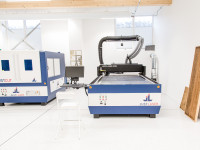Technological advances in laser cutting of wood
Laser cutting of wood has become increasingly important in recent years thanks to technological progress.
Technological advances in wood laser cutting have made woodworking more precise and faster than ever before. The latest technologies offer a variety of ways to cut, engrave or mark wood the way you want. These advances allow wood dealers and processors to produce their products to the highest standards to meet their customers' needs.
Laser cutting of wood has become increasingly important in recent years thanks to technological progress. It is a precise and efficient process that allows wood to be processed quickly and cost-effectively.
But before we look at the advantages of this technology, it is worth taking a look at the historical development of laser cutting. The first lasers were developed as early as the 1960s, but they were not yet suitable for cutting materials. It was not until the 1970s that the first successful use of laser cutting was achieved. Since then, this technology has steadily evolved and today offers a wide range of possibilities for woodworking.
Historical development of laser cutting
The historical development of laser cutting is closely linked to the discovery of the laser in 1960. Initially, laser cutting was mainly used in industry for cutting and forming metals. Over time, the technology was improved and applied to other materials such as wood. Today, laser cutting of wood is a popular process in many fields, from furniture manufacturing to architecture, due to its precision and efficiency. Thanks to technological advances, wood can now be cut faster and more precisely than ever before. This has not only shortened production times, but also reduced costs and improved quality.
Technological advances in laser cutting of wood
Thanks to advanced technologies and modern machines, wood products can be manufactured quickly, precisely and cost-effectively. Laser cutting of wood has many advantages over traditional cutting methods. It is a fast and efficient way to cut complex designs and patterns in wood. It also allows for high precision and accuracy, resulting in improved product quality and less waste. Laser technology has also opened up the possibility of processing wood in a variety of ways: Laser cutting and laser engraving. Overall, technological advances in laser wood cutting have made the manufacture of wood products easier and more efficient.
Advantages of wood laser cutting
The advantages of wood laser cutting are numerous, making this technology an increasingly popular choice in woodworking. One of the biggest advantages is the precision with which the material can be cut. Lasers can be used to create complex shapes and patterns that would be difficult or impossible to achieve with traditional tools. In addition, laser cutting of wood is very fast and efficient, which saves time and money. Another advantage is the ability to cut different types of wood, including thicker and harder materials.
How does laser cutting of wood work?
This technology is based on the use of lasers that generate a very focused and intense beam of light. This beam is directed at the material to be processed and generates a fusion line by heat that separates the material. When laser cutting wood, the beam is adjusted to heat only a small portion of the material, thus cutting only a thin layer. This creates a precise and clean cut edge without fraying or splintering of the wood. The advantage of this technology is that it is faster than conventional sawing or milling methods and requires no finishing. Even complex shapes can be produced without any problems. However, there are also limitations to the use of wood laser cutting, as not all types of wood can be cut equally well and discoloration can occur due to the heat generated.
Costs and benefits of laser cutting of wood
Another advantage of laser cutting of wood is cost efficiency. Compared to conventional methods such as sawing or milling, laser cutting can save a considerable amount of time and money. The reason for this is that the laser beam works very precisely and thus less material is wasted.
In addition, lasers can be used to cut complex shapes and designs that would be difficult or impossible to achieve with conventional tools. The possibility of automated production also contributes to cost efficiency. In addition to cost, laser cutting of wood also offers numerous advantages in terms of the quality and precision of the cut parts.
The use of lasers allows very fine and clean cuts to be produced, which is particularly important in the manufacture of furniture or works of art. In addition, the surface of the cut material remains smooth and undamaged, which offers further advantages in terms of aesthetics and durability.
Fast, safe and economical machining
Technological progress in the field of wood laser cutting opens up new possibilities in wood processing. The areas of application are diverse and range from furniture production to the manufacture of packaging materials and the design of art objects. The advantages of wood laser cutting lie primarily in its fast, precise and cost-effective processing. By using modern laser technology, even complex shapes and filigree patterns can be realized without any problems.
The process is not only efficient, but also environmentally friendly, as it does not require any chemical additives and therefore does not produce any harmful emissions. In terms of safety, wood laser cutting is also convincing thanks to its high precision and automated process flow. Overall, it can be said that the technological advances in wood laser cutting represent a promising future for wood processing and already offer numerous advantages today.


